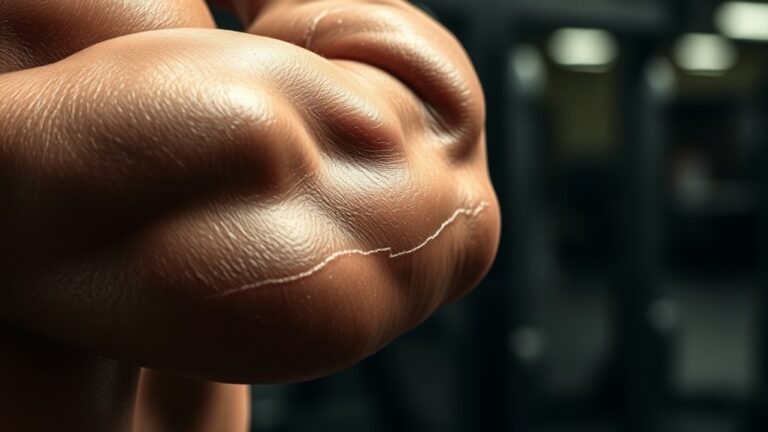How to Rebuild Strength After a Broken Bone

Rebuilding strength after a broken bone involves understanding the healing stages and engaging in tailored physical therapy. Start with gentle weight-bearing exercises to gradually rebuild strength, and incorporate flexibility and range of motion work. Nutrition plays a key role, so focus on calcium and vitamin D-rich foods. Listen to your body and manage pain effectively. Set realistic recovery goals to stay motivated. There’s much more to learn about optimizing your recovery journey and enhancing your strength.
Understanding the Healing Process

When you break a bone, your body goes through a complex healing process that’s fundamental for recovery. This process involves several healing stages, starting with inflammation, where blood clots form to stabilize the area. Next, the soft callus stage begins, during which your body lays down new tissue to bridge the fracture.
As healing progresses, the hard callus forms, providing more stability. This is when your body starts the critical phase of bone remodeling. During this stage, the hard callus is replaced with new bone, restoring strength and structure.
It’s essential to let each stage unfold naturally, as rushing can lead to complications. Maintaining proper nutrition and following medical advice supports this process, ensuring your bones heal correctly. Understanding these healing stages and the importance of bone remodeling can help you feel more secure and informed as you navigate your recovery journey.
Importance of Physical Therapy
When you’re recovering from a broken bone, physical therapy can make a huge difference in your rehabilitation. It provides essential benefits, like improving strength and mobility, while a professional guides you through tailored exercises. This support not only speeds up your recovery but also helps prevent future injuries.
Benefits of Rehabilitation Programs
While healing from a broken bone, engaging in a rehabilitation program can be a game changer for your recovery. These programs offer numerous rehabilitation benefits that can greatly enhance your strength and mobility. You’ll learn safe exercises tailored to your needs, helping to rebuild the muscle around the injury without risking further damage. Gradually increasing your activity level guarantees you’re not pushing yourself too hard, promoting program success. Plus, being part of a structured program keeps you accountable, making it easier to stick with your recovery goals. By participating in rehabilitation, you’re investing in a safer, more effective path to regain your strength and confidence, which is vital for returning to your daily activities.
Role of Professional Guidance
Professional guidance is essential for a successful recovery from a broken bone, as it guarantees you receive personalized care tailored to your specific needs. Engaging with a physical therapist provides you with professional expertise that focuses on safe and effective recovery strategies. They’ll assess your condition and create a customized plan to rebuild your strength without risking further injury.
With their support, you can learn proper techniques for exercises that enhance mobility and stability. You’ll also gain valuable insights into pacing your rehabilitation process, ensuring you don’t push your body too hard too soon. Overall, professional guidance not only boosts your confidence but also promotes a safer, more efficient recovery journey. Trusting in their expertise is a crucial step toward regaining your full strength.
Gradual Weight-Bearing Exercises

As you begin your recovery from a broken bone, incorporating gradual weight-bearing exercises is essential for rebuilding strength and promoting healing. Start with minimal weight and slowly increase the load—this method is known as progressive loading. It helps your bones adapt without risking further injury.
Begin with simple activities, like standing on one leg to improve balance. Balance exercises not only strengthen muscles but also enhance stability, reducing the risk of falls. As you gain confidence, you can progress to walking, using a cane or walker if needed for safety.
Always listen to your body; if you feel pain, stop and consult your healthcare provider. They can guide you on how to safely advance your routine. Remember, gradual weight-bearing exercises are key to regaining strength while ensuring a safe recovery process. Prioritize your safety, and take it one step at a time.
Strength Training Techniques
What strength training techniques can help you recover effectively after a broken bone? Start with bodyweight exercises, like squats and push-ups, which engage your muscles without straining your injury. As you gain confidence, gradually introduce resistance training using light weights or resistance bands. This approach guarantees you’re building strength safely while minimizing the risk of re-injury.
Focus on strength progression by increasing intensity gradually. Listen to your body; if something feels off, don’t push through the pain. Incorporate recovery workouts to allow your muscles to heal properly. These workouts can include gentle stretching and low-impact activities like swimming or cycling, promoting blood flow and aiding recovery.
Always consult with a healthcare professional before starting any new exercise routine. They can provide guidance tailored to your specific situation, guaranteeing you rebuild strength safely and effectively.
Incorporating Flexibility and Range of Motion

While rebuilding strength after a broken bone is essential, incorporating flexibility and range of motion exercises is equally important for a full recovery. As you progress in your healing journey, focus on dynamic stretching and mobility drills to improve your joint function and prevent stiffness. Start with gentle movements to gradually ease into stretches, guaranteeing you listen to your body and avoid pushing through pain.
Incorporating exercises like arm circles, leg swings, and torso twists can enhance your flexibility while promoting blood flow to the affected area. Remember to hold stretches only as long as feels comfortable and to perform mobility drills at a slow, controlled pace. This approach not only aids in recovery but also helps you regain confidence in your movement. By prioritizing flexibility and range of motion, you’ll set a solid foundation for your strength training efforts and guarantee a safer return to your regular activities.
Nutrition for Bone Health
When you’re recovering from a broken bone, what you eat plays an important role in your healing process. Essential nutrients like calcium and vitamin D are key for bone strength, while staying hydrated helps support overall recovery. Let’s explore how you can optimize your nutrition for better bone health.
Essential Nutrients for Healing
To guarantee effective healing after a broken bone, it’s essential to focus on the important nutrients your body needs. Key nutrients like calcium and protein play a significant role in bone health and recovery. Calcium sources such as dairy products, leafy greens, and fortified foods help rebuild bone density. Adequate protein intake is also critical, as it supports tissue repair and muscle strength.
Here’s a quick overview of essential nutrients for healing:
| Nutrient | Sources |
|---|---|
| Calcium | Milk, yogurt, spinach |
| Protein | Chicken, beans, nuts |
| Vitamin D | Sunlight, fatty fish, eggs |
Incorporating these nutrients into your diet can promote a safe and effective healing process, ensuring you regain your strength and mobility.
Importance of Hydration
Have you ever considered how hydration impacts your bone health? Staying properly hydrated is essential for your recovery after a broken bone. Ideal fluids, like water and herbal teas, help transport essential nutrients to your bones, promoting healing. When you’re dehydrated, your body can’t function at its best, which may slow down recovery.
To implement effective hydration strategies, aim to drink water throughout the day and include hydrating foods, such as fruits and vegetables. Avoid excessive caffeine or alcohol, as these can dehydrate you. Remember, the goal is to keep your body well-hydrated, so listen to your thirst cues. Prioritizing hydration not only supports your bone health but also contributes to your overall well-being during the healing process.
Listening to Your Body: Pain Management
As you commence on the journey of recovery after a broken bone, tuning into your body’s signals is essential for effective pain management. Developing body awareness can help you identify pain signals that indicate when you might be pushing too hard or not moving correctly. Listen closely to your body; if you feel sharp or unusual pain, take a step back. It’s vital to differentiate between discomfort from strengthening muscles and pain that could signal a setback.
Using techniques like deep breathing or gentle stretching can help manage discomfort while still promoting healing. Remember, some soreness is expected, but you shouldn’t ignore pain that feels excessive or unmanageable. If you’re unsure about what you’re experiencing, don’t hesitate to consult a healthcare professional. They can provide guidance tailored to your specific recovery needs, ensuring you stay safe while rebuilding strength. Prioritize your comfort and well-being throughout this process.
Setting Realistic Recovery Goals
Listening to your body is a key part of recovery, and that includes setting realistic goals. It’s vital to have realistic expectations during your healing process. Start by breaking down your recovery into smaller, manageable milestones. This approach helps guarantee you’re not pushing yourself too hard too soon. For example, instead of aiming to run a mile right away, focus on walking for a few minutes each day.
Utilize goal setting strategies that prioritize safety and gradual progression. Consider consulting with a healthcare professional to tailor your goals based on your specific situation. Regularly reassess your progress, and don’t hesitate to adjust your goals if needed. Remember, recovery isn’t a race; it’s about rebuilding strength safely and effectively. By setting achievable targets, you’ll foster a sense of accomplishment without risking further injury.
Staying Positive and Motivated
While recovering from a broken bone can be challenging, staying positive and motivated is essential for your overall healing journey. A positive mindset can greatly impact your recovery, helping you push through tough days. Here are three motivational techniques to keep your spirits high:
Staying positive and motivated is crucial for healing; it helps you navigate the challenges of recovery with resilience.
- Celebrate Small Wins: Acknowledge every little achievement, whether it’s a step without crutches or increased mobility. These victories build your confidence.
- Visualize Your Success: Picture yourself fully recovered and engaging in activities you love. This visualization can inspire and drive you forward.
- Connect with Supportive People: Surround yourself with friends and family who uplift you. Their encouragement can be a powerful motivator during difficult times.
Frequently Asked Questions
How Long Does It Typically Take to Regain Full Strength?
Typically, regaining full strength can take several months, depending on various factors like age and overall health. You should expect a healing timeline that includes gradual strength milestones. Initially, you might notice progress in mobility and stability before building muscle strength. It’s important to listen to your body and consult with a healthcare professional to guarantee you’re safely advancing through these milestones without risking further injury. Patience and consistency are key!
What Signs Indicate I’m Pushing Too Hard During Recovery?
During any recovery, it’s vital to pay attention to your body. If you notice pain signals, like sharp pain or prolonged soreness, it’s a sign you might be pushing too hard. You should also listen for fatigue or weakness, which can indicate you’re exceeding your recovery limits. Remember, progress takes time, and prioritizing safety can help guarantee a smoother healing process. Always consult with a healthcare professional if you’re unsure.
Can I Still Exercise Other Body Parts While Healing?
Did you know that nearly 80% of people can maintain fitness levels through cross training while recovering from injuries? Yes, you can still exercise other body parts while healing, but it’s essential to use safe modifications. Focus on low-impact activities like swimming or cycling for your legs, while ensuring you don’t strain the injured area. Always listen to your body and consult a professional to tailor a program that respects your recovery process.
Are There Any Supplements That Can Aid Recovery?
When considering supplements to aid recovery, you might want to focus on calcium sources and vitamin D. Calcium is essential for bone health, so incorporating dairy products, leafy greens, or fortified foods can be beneficial. Vitamin D helps your body absorb calcium, so getting sun exposure or considering a supplement could also be wise. Always consult your doctor before starting any new supplements to guarantee they’re safe and right for your recovery.
How Can I Prevent Future Fractures After Recovery?
An ounce of prevention’s worth a pound of cure. To prevent future fractures, focus on bone health by incorporating calcium and vitamin D into your diet. Regular weight-bearing exercises can strengthen your bones. Staying active helps maintain balance, reducing fall risks. Also, consider getting regular check-ups to monitor bone density. Remember, safe habits now can save you pain later. Prioritize your health, and you’ll keep those bones strong for years to come.





